GRASS ROOTS ADVOCACY
 A lawn is made up of thousands of individual grass plants. There are several grass species in most lawns, but they all grow in similar ways.
A lawn is made up of thousands of individual grass plants. There are several grass species in most lawns, but they all grow in similar ways.
Lawn grasses are perennial: Even when the leaves die back during cold temperatures or drought, the roots survive beneath the ground, ready to send up new leaves when the weather improves.
In fact, new leaves emerge continuously during the growing season, with young leaves continuously replacing older ones. Clusters of new leaves can also appear away from the original plant, spread there through underground runners known as rhizomes. In these ways, a healthy lawn continuously renews itself, filling in gaps to create a soft and fresh-looking carpet of green that makes our parks beautiful, welcoming, and resilient.
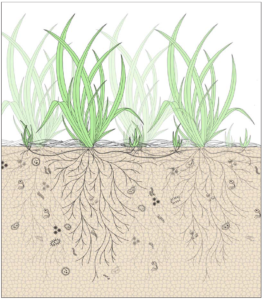 Healthy leaves require healthy roots, and a healthy lawn requires a healthy soil.
Healthy leaves require healthy roots, and a healthy lawn requires a healthy soil.
Leaves serve the grass plant by using sunlight to convert water and carbon dioxide into sugar and oxygen. The leaves release oxygen into the atmosphere and send sugar down to the roots. Is this clear – how sunlight helps grass plants convert water and carbon dioxide into sugar and oxygen? At the risk of giving too much information, do we need to say why grass plants need carbon dioxide?
Although the leaves can absorb carbon dioxide directly from the air around them, they rely on the roots to provide them with water and minerals and to store the sugars they generate. At the end of the winter, or after a summer drought, these stored sugars allow the plant to break dormancy and send up new leaves.
As the roots grow, they improve soil around them. A healthy soil is porous and alive. Roots depend on the movement of water and air through the soil, and on the microorganisms that live in it, which convert nutrients into (one word) forms that plants can use. In turn, the roots aerate the soil, and secrete sugars that support soil life.
The entire system – leaves, roots, and soil – depends on sunlight, water, and good care.
 All plants need sunlight. Although some plants can thrive in shade, grasses do best when they get a full day of sun.
All plants need sunlight. Although some plants can thrive in shade, grasses do best when they get a full day of sun.
Sunlight powers photosynthesis, which enables plants to store energy in the form of sugars. These sugars not only power new growth in the spring but also allow grass to recover quickly from damage. The vigor that sunlight provides is essential to the resilience of heavily-used lawns like the ones on the Common.
Sunlight is also valuable because it warms the soil. During cool nights, the soil becomes still. Morning sun wakes up the soil, jump-starting the metabolism of roots and microorganisms, and speeding the circulation of water and air. Where there is morning sun, plants are ready early for a full day of vigorous growth. Do we need a sentence on the consequences, in a heavily used site, of not allowing the plants to have morning sun/warm soil?
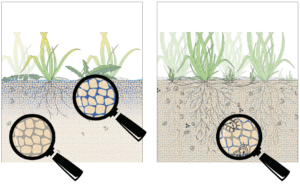 Lawns need water, but sometimes too much water is worse than too little. Too much water can weaken the lawn, but watering in moderation make lawns greener and more resilient. Careful watering is important on every lawn, but especially on hard-working lawns like the Common’s.
Lawns need water, but sometimes too much water is worse than too little. Too much water can weaken the lawn, but watering in moderation make lawns greener and more resilient. Careful watering is important on every lawn, but especially on hard-working lawns like the Common’s.
Roots need air as well as water. When the soil is slightly damp, the roots have access to both. But when the soil is saturated, water fills all the pore spaces and there is no room for air to circulate. Without access to air, the roots go dormant: they stop growing, and they stop feeding the plant. If the soil is wet for too long, the plant will decline.
We should add that too much moisture cools the soil, which has an impact on growth.
Even though dry conditions can also stress the plant, short periods of dry soils can improve the lawn’s health. When water becomes scarce near the soil surface, roots dig deeper in their search for water. These deep roots not only help the plants during droughts, but they help build a deep porous soil that teems with beneficial microorganisms, improving the lawn’s health in all seasons.
Even while the roots are venturing deeper, the leaves may dry out and the lawn may start to turn from green to brown. That’s actually a sign that the lawn is responding properly to the weather: turf grasses cope with heat and drought by holding water in their roots rather than their leaves. If the roots are deep and healthy, they can send up fresh green shoots as soon as moisture returns.
Irrigation can help keep the grass green, but it needs to be used with care:
- Summer is the only season when rainfall doesn’t provide sufficient water for lawns. In the spring, frequent rains and cool temperatures keep soils moist. In the fall, temperatures cool down again and lawns begin their natural transition to winter dormancy. As tempting is it is to turn the sprinklers on at the first sign of green, irrigation is only beneficial from June to September.
- Frequent watering leads to shallow root systems. When the top layer of soil is wetter than the soil below, roots grow horizontally rather than down. Over time the root system becomes a mat just below the soil surface. This dense but shallow root system leaves the grass plant dependent on frequent watering and vulnerable to thatch and root rot.
- To create a more resilient lawn, with deep-roots that can bounce back from drought and other stresses, watering should be deeper and less frequent. One thorough watering a week is plenty, even when the weather is hot and dry. Watering can decrease in milder conditions and it can stop when rain is frequent.
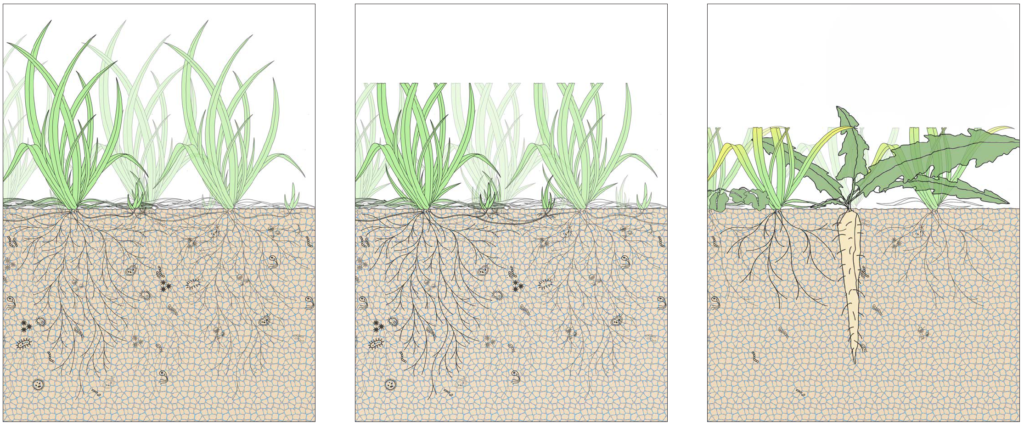 Good mowing helps build healthy lawns. Grasses have evolved to grow back stronger and thicker after being mown – as long as the mowing is moderate and well-timed. Proper mowing encourages the plant to spread by rhizomes and to grow new roots. But if a lawn is mown too low, when the weather is too hot, or too soon after fertilization, the loss of leaf area will weaken the plant, reduce root growth, encourage weed germination, and cause premature brown-out.
Good mowing helps build healthy lawns. Grasses have evolved to grow back stronger and thicker after being mown – as long as the mowing is moderate and well-timed. Proper mowing encourages the plant to spread by rhizomes and to grow new roots. But if a lawn is mown too low, when the weather is too hot, or too soon after fertilization, the loss of leaf area will weaken the plant, reduce root growth, encourage weed germination, and cause premature brown-out.
Mowing can contribute to lawn health when it follows these guidelines:
- Grass shouldn’t be cut too low. Mower blades can be adjusted, and they should be set to a height of three inches or more.
- Mowing frequency should be based on how fast the lawn is growing. Each mowing should remove no more than one-third of the grass’s height. With a blade set at three inches, that means mowing when the lawn is about four inches high. So the lawn should be mowed more often when it’s growing rapidly, and less often when it’s growing slowly.
- The benefits of mowing depend on the grass’s ability to respond with vigorous new growth. When the grass is stressed by other factors, mowing can do more harm than good, and should be suspended briefly. Lawns should not be mowed within a week after any chemical treatment, and they should never be mowed when the temperature is above 90 degrees.
- Will this paragraph be controversial, with BPRD? I think we should share all this with Josh – would be good to have his sign-off, and support.
- Mowing can also be harmful when soils are wet. Lawnmowers are heavy, and wet soils are vulnerable to compaction. Mowing after a rain can damage roots and soil, and leaving ugly ruts where it’s difficult for grass to grow back. Usually a day’s time will be sufficient for the soil to dry out enough for mowing.
- Good, well-maintained equipment makes a difference too: Sharpened mower blades make cleaner cuts, and mulching mowers keep nutrients on site, reduce water loss, and eliminate the cost of off-site disposal.Mulching mowers – another big issue. Should we keep in?
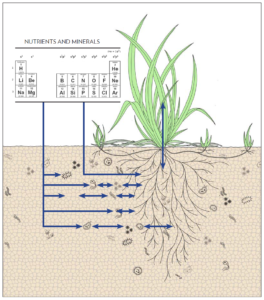
Like people, plants need a variety of minerals for healthy growth. Plants can absorb some minerals directly from the soil, but they rely on soil organisms to deliver other minerals in a form that they can use.
A healthy soil is a living system, known as the soil food web. As roots grow and die, they open up pores in the soil and provide food for insects and microbes. Roots, worms, and microbes work together to aggregate soil into a porous “crumb structure” that facilitates nutrient exchange and the movement of air and water. Fungi and bacteria break down dead plant and animal tissue, mobilizing the nutrients it contains. And fungi intertwine with root systems, supplying the roots with nitrogen and minerals in exchange for sugars exuded by each growing rootlet.
Because plants are interdependent with soil organisms, there are two ways to provide them with supplemental nutrients:
We can feed the plant directly. When we add elements like silicon, __, and __ to the soil, plants can absorb them directly and put them to use. Silicon, for example, helps reinforce the structure of leaves; __ helps the plant do __, and __ is essential to the plant’s __.
We can also feed the plant by feeding the soil. Certain minerals help support the organisms that support the plant; others can only be absorbed by the plant once a soil organism has converted it to a form the plant can use. __ is applied in the form of __; in the soil, __ convert it to __ and transport it to the roots. __ helps the growth of __, and __.
Another way to feed the soil is to add leaf mulch, compost, or the clippings created by a mulching mower. As these materials decay, they nourish the soil food web and travel through it to the plant’s roots. The nutrients in these materials are less vulnerable than applied fertilizers to being washed away in the rain, and make a good complement to the minerals that need to be applied directly.
As with mowing and watering, timing and quantity are important. For example, if __ is applied too late in the season, it can spur the plant to put on new growth at exactly the time it ought to be going dormant. And any nutrient applied in excess will be washed away by the rain, leading to harm downstream. Nitrogen can boost plant growth, for example, but if it percolates into the soil it can pollute the aquifer below, and if it flows into a river, lake, or harbor it can harm fish and wildlife. For these reasons, it is important to apply nutrients with great care.
GRASS ROOTS ADVOCACY
Hover over the image to learn more about it.
1. How Grass Thrives
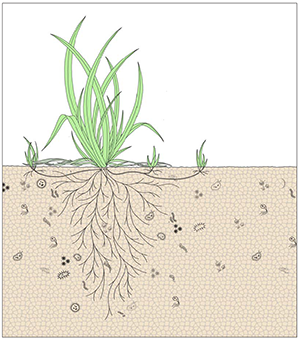
2. Healthy leaves, healthy roots, healthy soil

Your Content Goes Here


